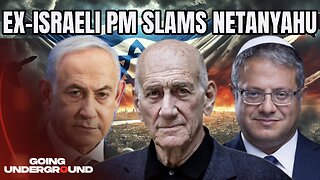Premium Only Content
Tracking MS-13 | What Does the Henrry Santos Arrest Mean?
The arrest of Henrry Josue Villatoro Santos, a high-ranking East Coast leader of MS-13, near the U.S. Capitol presents an immediate and deeply concerning national security situation. Initial threat interpretation frames Santos as a strategic-level operational actor, likely involved in preparing or coordinating a violent or high-impact action within the Washington, D.C. region. His presence, armed and embedded in suburban Virginia, occurred during a period of reduced FBI presence in the area, following the bureau’s 2025 personnel redistribution. This convergence of motive, means, and opportunity suggested a live, imminent threat scenario—one with potential implications ranging from coordinated regional attacks to retaliatory violence against U.S. political or law enforcement targets.
MS-13 has a known history of adapting rapidly under pressure, particularly when its leadership is threatened or disrupted. Recent moves by the U.S. administration—including the designation of MS-13 as a Foreign Terrorist Organization and expanded use of immigration-era wartime authorities—have sharply escalated that pressure. Santos, as a central logistics coordinator and transnational communications asset, would be a natural figure to lead or greenlight retaliatory actions. His presence in Woodbridge could therefore have marked either a final staging point before a planned operation, or an urgent in-person attempt to stabilize East Coast cliques under internal strain. Either possibility warranted immediate action and full-spectrum intelligence exploitation.
However, the circumstances of his arrest—and the unusual optics of the federal response—introduce an even more unsettling secondary possibility: that Santos’s exposure was intentional, and his capture served a larger strategic function. In this alternative interpretation, Santos may have functioned as bait—a high-value decoy deployed by MS-13 or cooperating entities to trigger a large, visible federal mobilization. The goal of such a maneuver would not be to avoid arrest, but to provoke a concentrated U.S. response, thereby revealing key assets, protocols, leadership roles, and interagency seams. This hypothesis aligns disturbingly well with the arrest’s most anomalous features.
The arrest prompted the rapid, concentrated deployment of multi-agency federal forces—including visible involvement from top-tier personnel such as the Attorney General and FBI Director. While such visibility projected strength and resolve, it also created a rare and predictable concentration of command assets in a single known location—one that could have been monitored, recorded, or even targeted by adversarial spotters. In the context of an intentional bait operation, this public display becomes a vulnerability: a live capture of federal response posture under pressure. Sophisticated criminal or proxy actors—especially those with cartel or foreign intelligence ties—could exploit this moment to gather visual IDs, signal intercepts, or comms routing metadata.
Adding to the concern is the limited operational yield of the arrest. No accomplices were captured. No immediate network was unraveled. No meaningful cache of intelligence—digital, human, or financial—has yet emerged. This asymmetry between the scale of the response and the singularity of the result raises the risk that the event was not just a disruption of MS-13’s hierarchy, but a deliberately managed disruption—an operational sleight of hand. If Santos was placed to be caught, his real function may have been to gather information on us, not the other way around.
Should this prove true, the national threat landscape must be reframed. We are not merely dealing with a gang under pressure but with an actor capable of strategic deception, willing to sacrifice high-value individuals in order to mislead, study, or destabilize adversaries. The implications are vast: personnel identities may have been exposed, surveillance patterns observed, response algorithms mapped.
In conclusion, whether Santos was captured in the midst of planning a violent act or deliberately positioned to lure federal leadership into exposure, the threat remains unresolved. His arrest is not a finish line but a breach in a larger pattern. Agencies must move swiftly to exploit any remaining intelligence, monitor for secondary actions or diversionary attacks, and most critically, conduct a silent review of all personnel, tactics, and digital footprints exposed during the operation. The question we now face is not only what was he doing there?—but what did we just reveal in responding?
-
 LIVE
LIVE
freecastle
6 hours agoTAKE UP YOUR CROSS- PROTECTING FREEDOM, PRESERVING HOPE!
281 watching -

The HotSeat
1 hour agoTrump Drops Hammer: Burn the Flag = 1 Year Prison! Army Deployment Next?!
4.95K11 -
 LIVE
LIVE
Jamie Kennedy
20 hours agoThe Truth About Anger, Race, & Feminine Energy w/ Jesse Lee Peterson | Ep 219 HTBITY
202 watching -
 1:45:39
1:45:39
The Quartering
6 hours agoMMA Fighter Tries To K*LL Wrestler, Hollywood PANIC & Sam Tripoli's Favorite Conspiracies
133K151 -
 1:05:04
1:05:04
Mark Kaye
5 hours ago🔴 Trump Sends Dems Into RAGE Over Flag Burning Executive Order
13.5K18 -
 LIVE
LIVE
Film Threat
19 hours agoVERSUS: AUGUST BOX OFFICE BLOOD BATH! MARVEL IS COOKED! | Film Threat Versus
114 watching -
![[Ep 734] Leftists Support of Black-on-Black Crime | Bolton Raid / Media Hypocrisy](https://1a-1791.com/video/fww1/0e/s8/1/a/F/p/c/aFpcz.0kob-small-Ep-734-Leftists-Support-of-.jpg) LIVE
LIVE
The Nunn Report - w/ Dan Nunn
2 hours ago[Ep 734] Leftists Support of Black-on-Black Crime | Bolton Raid / Media Hypocrisy
178 watching -
 29:39
29:39
Afshin Rattansi's Going Underground
1 day agoEx-Israeli PM Ehud Olmert: INTOLERABLE Amount of Innocent Palestinians Have Been Killed in Gaza
10K28 -
 7:49
7:49
Dr. Nick Zyrowski
6 months agoVitamin D is Dangerous? Get The TRUTH!
10.4K11 -
 1:03:48
1:03:48
daniellesmithab
3 hours agoExploring Nuclear Energy in Alberta
15.2K6